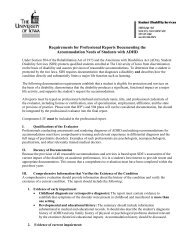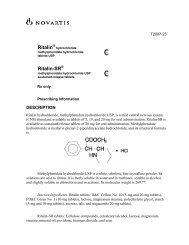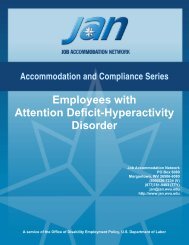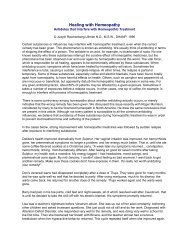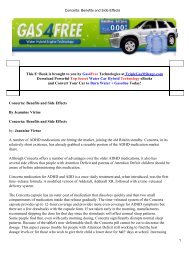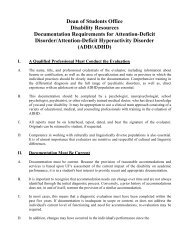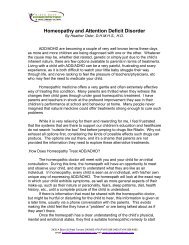Emergency Department Visits Involving ADHD ... - ADHD Info Centre
Emergency Department Visits Involving ADHD ... - ADHD Info Centre
Emergency Department Visits Involving ADHD ... - ADHD Info Centre
Create successful ePaper yourself
Turn your PDF publications into a flip-book with our unique Google optimized e-Paper software.
Issue 29, 2006<br />
<strong>Emergency</strong> <strong>Department</strong> <strong>Visits</strong> <strong>Involving</strong><br />
<strong>ADHD</strong> Stimulant Medications<br />
In Brief<br />
According to the Drug Abuse Warning<br />
Network (DAWN) for 2004:<br />
■ An estimated 7,873 drug-related<br />
emergency department (ED)<br />
visits involved methylphenidate or<br />
amphetamine-dextroamphetamine, two<br />
medications used to treat attentiondefi<br />
cit/hyperactivity disorder (<strong>ADHD</strong>).<br />
■ The most frequent reason for these visits<br />
was nonmedical use (48%), followed<br />
by adverse reactions associated with<br />
medical use (34%), accidental ingestion<br />
(10%), and suicide attempts (8%).<br />
■ The rates of ED visits involving<br />
methylphenidate or amphetaminedextroamphetamine<br />
for patients aged<br />
12 to 17 were higher than the rates for<br />
patients aged 18 or older.<br />
■ Over two thirds (68%) of the visits<br />
involving nonmedical use of these two<br />
drugs also involved another substance,<br />
such as alcohol, an illicit drug, or<br />
pharmaceutical.<br />
Recent studies have indicated that as many<br />
as 7 percent of children and 4 percent of<br />
adults now meet the criteria for a diagnosis<br />
of attention-deficit/hyperactivity disorder<br />
(<strong>ADHD</strong>). 1,2,3 As a result, more prescriptions are<br />
being written for the stimulants used to treat<br />
<strong>ADHD</strong>. More prescriptions will likely lead to<br />
increases in medical side effects associated with the<br />
use of these medications and, potentially, greater<br />
use of these drugs for nonmedical purposes as<br />
well. 4 A recent Food and Drug Administration<br />
(FDA) advisory panel recognized the danger of side<br />
effects for <strong>ADHD</strong> stimulants and recommended<br />
that they carry a warning of an increased potential<br />
for cardiac problems, such as hypertension, cardiac<br />
arrests, and stroke. 5 The possibility of medical<br />
problems may be exacerbated by using <strong>ADHD</strong><br />
stimulant medications improperly or in combination<br />
with other drugs.<br />
The potential for greater access of these medications<br />
to persons without a prescription is supported<br />
by research, which has shown that peers are a<br />
common source of <strong>ADHD</strong> medications. 6 Although<br />
the potential for diversion has increased, estimates<br />
from the 2003 National Survey on Drug Abuse<br />
and Health (NSDUH) indicate that nonmedical<br />
use of <strong>ADHD</strong> stimulant medications is still relatively<br />
low: 0.3 percent of the population aged 12 or<br />
older reported using such stimulants nonmedically<br />
during the past year. However, those aged 18 to<br />
The DAWN Report is published periodically by the Offi ce of Applied Studies (OAS), Substance Abuse and Mental Health Services Administration<br />
(SAMHSA). This issue was written by Scott P. Novak, Ph.D. (RTI International, a trade name of Research Triangle Institute) and Judy K. Ball,<br />
Ph.D., M.P.A. (SAMHSA/OAS). All material in this report is in the public domain and may be reproduced or copied without permission from<br />
SAMHSA. Citation of the source is appreciated.
The DAWN Report — <strong>Emergency</strong> <strong>Department</strong> <strong>Visits</strong> <strong>Involving</strong> <strong>ADHD</strong> Stimulant Medications Issue 29, 2006<br />
25 had a higher rate of nonmedical use than those who<br />
were younger or older. 7 College students, who may<br />
use these drugs as study aids because of their stimulant<br />
properties, fall primarily in this 18-to-25 age group.<br />
The Drug Abuse Warning Network (DAWN), which<br />
collects data from a national sample of short-term,<br />
general, non-Federal hospitals, 8 provides estimates of<br />
drug-related emergency department (ED) visits. The<br />
findings presented in this issue of The DAWN Report<br />
are based on ED visits related to two of the pharmaceuticals<br />
commonly used to treat <strong>ADHD</strong>—methylphenidate<br />
and amphetamine-dextroamphetamine. DAWN<br />
includes both generic and branded drugs, including<br />
methylphenidate marketed as Ritalin © and Concerta ©<br />
and amphetamine-dextroamphetamine marketed as<br />
Adderal © . Based on DAWN data, this report examines<br />
the reasons for the ED visits and the relative frequency<br />
of these ED visits for different age groups. Finally, for<br />
the ED visits involving nonmedical use, DAWN provides<br />
the ability to examine the drugs used along with<br />
the <strong>ADHD</strong> drugs. DAWN, which observes drug-related<br />
morbidity in ED visits, offers a different view of drug<br />
use than the NSDUH, which measures prevalence of<br />
nonmedical use in the population at large.<br />
Overview<br />
In 2004, about 106 million ED visits occurred in<br />
short-term, general, non-Federal hospitals in the United<br />
States. 9 DAWN estimates that about 2 million ED visits<br />
in 2004 were drug related, and the <strong>ADHD</strong> drugs examined<br />
in this report were implicated in under 1 percent of<br />
those drug-related visits. Methylphenidate was involved<br />
in an estimated 3,601 ED visits, and amphetaminedextroamphetamine<br />
was involved in an estimated 4,272<br />
ED visits.<br />
Reasons for ED visits<br />
Among the 7,873 ED visits involving one of the <strong>ADHD</strong><br />
medications, nonmedical use accounted for 48 percent<br />
of the visits and medical use (i.e., adverse reaction)<br />
accounted for 34 percent (Table 1). Nonmedical use<br />
includes cases when a higher than prescribed dose was<br />
used, a drug prescribed for another person was used,<br />
or there was other evidence in the medical record of<br />
drug misuse or abuse. Considerably fewer of the ED<br />
visits were associated with accidental ingestion (10%) or<br />
suicide attempt (8%). 10<br />
Patient age<br />
As mentioned above, findings from the NSDUH suggest<br />
that nonmedical use of <strong>ADHD</strong> drugs is more frequent<br />
among those aged 18 to 25 than among younger (e.g.,<br />
12 to 17) or older (26 or older) age groups. DAWN<br />
estimates show that the rate of ED visits involving<br />
<strong>ADHD</strong> stimulants is highest among patients aged 12<br />
to 17 (Figure 1). This pattern is found for both medical<br />
and nonmedical use of these stimulants. These findings<br />
suggest that younger persons (aged 12 to 17) are<br />
at greater risk for adverse health effects, despite being<br />
less likely than those aged 18 to 25 to use <strong>ADHD</strong> drugs<br />
nonmedically.<br />
Drug combinations<br />
ED visits involving adverse reactions associated with<br />
medical use usually involve only a single drug. For<br />
methylphenidate or amphetamine-dextroamphetamine,<br />
about three quarters (77%) of adverse-reaction visits<br />
involved only the single drug.<br />
Table 1. Estimated ED visits, by reason for ED visit and drug<br />
Methylphenidate<br />
Amphetaminedextroamphetamine<br />
Total<br />
Reason for visit ED visits % of visits ED visits % of visits ED visits % of visits<br />
Total a 3,601 100% 4,272 100% 7,873 100%<br />
Nonmedical use 1,541 43% 2,228 52% 3,769 48%<br />
Adverse reaction (medical use) 1,322 37% 1,320 31% 2,642 34%<br />
Accidental ingestion 390 11% 435 10% 825 10%<br />
Suicide attempt 348 10% 289 7% 637 8%<br />
a<br />
The total includes only the four types of ED visits shown. This excludes patients who presented to the ED specifi cally to seek admission to the hospital’s detoxifi cation<br />
or substance abuse treatment unit.<br />
Source: Offi ce of Applied Studies, SAMHSA, Drug Abuse Warning Network, 2004 (09/2005 update).
Issue 29, 2006<br />
The DAWN Report — <strong>Emergency</strong> <strong>Department</strong> <strong>Visits</strong> <strong>Involving</strong> <strong>ADHD</strong> Stimulant Medications<br />
For ED visits associated with nonmedical use,<br />
polydrug use is typical. This is important because the<br />
combination of <strong>ADHD</strong> medications with alcohol, illicit<br />
drugs, and other pharmaceuticals may amplify the<br />
health risks.<br />
Multiple drugs were present in about two thirds<br />
(68%) of the nonmedical-use visits involving methylphenidate<br />
or amphetamine-dextroamphetamine (Table 2).<br />
Alcohol was present in 20 percent of visits, illicit drugs<br />
in 26 percent, and other pharmaceuticals in 57 percent.<br />
Notes<br />
1. Robison, L.M., Sclar, D.A., Skaer, T.L., & Galin. R.S. (1999). National trends<br />
in the prevalence of attention-defi cit/hyperactivity disorder and the prescribing<br />
of methylphenidate among school-age children: 1990–1995. Clinical<br />
Pediatrics, 38(4), 209–218.<br />
2. Wender, P. H. (1998). Pharmacotherapy of attention-defi cit/hyperactivity<br />
disorder in adults. Journal of Clinical Psychiatry, 59 (supp. 7), 76–79.<br />
3. Kessler, R.C., Adler, L., Barkley, R., Biederman, J., Conners, C.K., Demler,<br />
O., Faraone, S.V., Greenhill, L.L., Howes, M.J., Secnik, K., Spencer, T.,<br />
Ustun, T.B., Walters, E.E., & Zaslavsky, A.M. (2006). The prevalence and<br />
correlates of adult <strong>ADHD</strong> in the United States: Results from the National<br />
Comorbidity Survey Replication. American Journal of Psychiatry, 163,<br />
716–723.<br />
4. Cohen, A. L., Jhung, M.A., & Budnitz, D.S. (2006, May 25). Stimulant<br />
medications and attention defi cit-hyperactivity disorder. New England Journal<br />
of Medicine, 354(21), 2294–2295.<br />
5. U.S. <strong>Department</strong> of Health and Human Services, Food and Drug Administration.<br />
(2006, January 6). Drug Safety and Risk Management Advisory<br />
Committee; Notice of Meeting. Washington, DC: Federal Register, 71(4), 942.<br />
6. McCabe, S.E., & Boyd, C.J. (2005). Sources of prescription drugs for illicit<br />
use. Addictive Behaviors, 30(7), 1342–1350.<br />
7. Kroutil, L.A., Van Brunt, D.L., Stahl, M.H., Heller, D.C., Bray, R. M., & Penne,<br />
M. A. (in press). Nonmedical use of prescription stimulants in the United<br />
States. Research Triangle Park, NC: RTI International.<br />
8. Specialty hospitals, including children’s hospitals, are excluded from the<br />
DAWN sample.<br />
9. AHA Annual Survey Database, Fiscal Year 2003. Health Forum LLC,<br />
Copyright 2004, One North Franklin Street, Chicago, IL 60606.<br />
10. DAWN does not collect data on preexisting conditions, so it is not possible to<br />
know whether a specifi c drug or a preexisting condition, such as depression,<br />
contributed to the suicide attempt.<br />
Figure 1. Rates of ED visits, by drug, type of<br />
use, and age<br />
ED visits per 100,000 population<br />
ED visits per 100,000 population<br />
4<br />
3<br />
2<br />
1<br />
0<br />
4<br />
3<br />
2<br />
1<br />
0<br />
1.7<br />
1.6<br />
1.0<br />
0.6<br />
0.4 0.4<br />
Nonmedical use<br />
Medical use<br />
0.3<br />
12–17 18–24 25–34 35+<br />
2.8<br />
1.2<br />
1.7<br />
0.6<br />
12–17 18–24<br />
Methylphenidate<br />
Amphetamine-dextroamphetamine<br />
0.8<br />
Source: Office of Applied Studies, SAMHSA, Drug Abuse Warning Network, 2004<br />
(09/2005 update).<br />
0.4<br />
0.4<br />
25–34 35+<br />
Table 2. Nonmedical use of <strong>ADHD</strong> medications in combination with other substances<br />
Methylphenidate<br />
Amphetaminedextroamphetamine<br />
Total %<br />
Total 1,541 2,227 3,768 100%<br />
Single drug 597 607 1,191 32%<br />
Multiple drugs a 944 1,620 2,564 68%<br />
with alcohol 341 413 754 20%<br />
with any illicit drug 331 662 993 26%<br />
with other pharmaceutical 810 1,329 2,139 57%<br />
a<br />
Components do not sum to total because categories are not mutually exclusive. For example, one multiple-drug visit may include alcohol and another pharmaceutical.<br />
Source: Offi ce of Applied Studies, SAMHSA, Drug Abuse Warning Network, 2004 (09/2005 update).
Official Business<br />
Penalty for Private Use $300<br />
For change of address, corrections, or to be removed from this<br />
list please e-mail: shortreports@samhsa.hhs.gov<br />
Presorted<br />
First Class<br />
U.S. Postage<br />
PAID<br />
Capitol Heights, MD<br />
Permit #4416<br />
Substance Abuse and Mental Health Services Administration<br />
Office of Applied Studies<br />
1 Choke Cherry Road, Room 7-1044<br />
Rockville, MD 20857<br />
For change of address, corrections, or to be removed from this<br />
list, please e-mail: shortreports@samhsa.hhs.gov.<br />
U.S. DEPARTMENT OF HEALTH & HUMAN SERVICES<br />
The DAWN Report —<br />
<strong>Emergency</strong> <strong>Department</strong> <strong>Visits</strong> <strong>Involving</strong> <strong>ADHD</strong> Stimulant Medications<br />
In Brief<br />
According to the Drug Abuse Warning Network<br />
(DAWN) for 2004:<br />
■ An estimated 7,873 drug-related emergency<br />
department (ED) visits involved methylphenidate<br />
or amphetamine-dextroamphetamine, two<br />
medications used to treat attention-defi cit/<br />
hyperactivity disorder (<strong>ADHD</strong>).<br />
■ The most frequent reason for these visits was nonmedical<br />
use (48%), followed by adverse reactions<br />
associated with medical use (34%), accidental<br />
ingestion (10%), and suicide attempts (8%).<br />
■ The rates of ED visits involving methylphenidate<br />
or amphetamine-dextroamphetamine for patients<br />
aged 12 to 17 were higher than the rates for<br />
patients aged 18 or older.<br />
■ Over two thirds (68%) of the visits involving<br />
nonmedical use of these two drugs also involved<br />
another substance, such as alcohol, an illicit drug,<br />
or pharmaceutical.<br />
The Drug Abuse Warning Network (DAWN) is a public health<br />
surveillance system that monitors drug-related morbidity and<br />
mortality. DAWN uses a probability sample of hospitals to<br />
produce estimates of drug-related emergency department (ED)<br />
visits for the United States and selected metropolitan areas<br />
annually. DAWN also produces annual profi les of drug-related<br />
deaths reviewed by medical examiners or coroners in selected<br />
metropolitan areas and States.<br />
Any ED visit or death related to recent drug use is included in<br />
DAWN. All types of drugs—licit and illicit—are covered. Alcohol<br />
is included for adults when it occurs with another drug. Alcohol is<br />
always included for minors. DAWN’s method of classifying drugs<br />
was derived from the Multum Lexicon, Copyright © 2005, Multum<br />
<strong>Info</strong>rmation Services, Inc. The Multum Licensing Agreement can<br />
be found in DAWN annual publications and at<br />
http://www.multum.com/license.htm.<br />
DAWN is one of three major surveys conducted by the Substance<br />
Abuse and Mental Health Services Administration’s Offi ce of<br />
Applied Studies (SAMHSA/OAS). For information on other<br />
OAS surveys, go to http://www.oas.samhsa.gov. SAMHSA has<br />
contracts with Westat (Rockville, MD) and RTI International<br />
(Research Triangle Park, NC) to operate the DAWN system and<br />
produce publications.<br />
For publications and additional information about DAWN, go to<br />
http://DAWNinfo.samhsa.gov.



